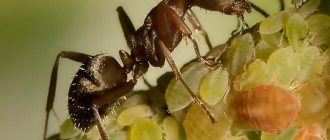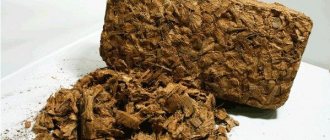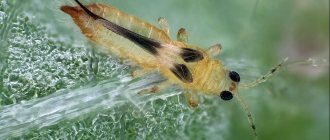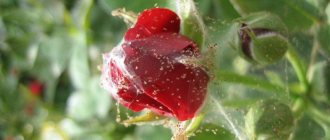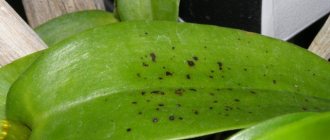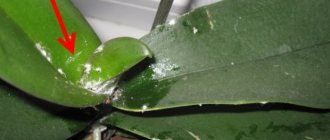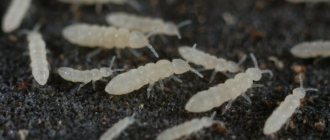Types of insects with descriptions and photos
The following types of mites can attack orchids::
- Root. This is a small spider, which is characterized by the presence of 3 pairs of legs, mustaches and a relatively large oval body. The pest is hardy, so it can remain without food for a long time. The main food is plant residues and underground parts of plants.
- False arachnoid. Pest. whose body grows only 0.3 mm in length. The body can take on different shades - from red to greenish. This variety does not entwine the plant with a web, so it can only be noticed after the appearance of a whole colony.
- Red spider mite. The danger of this parasite lies in the fact that most drugs act on it, so the pest is able to remain on the surface of the plant for a long time. The body may be red, yellow or orange.
- Bulbous. This species is small and moves slowly. The length of the bulb mite reaches 0.6 mm. The color of the pest is brown, the jaws are the same color. Spherical limbs.
- Flat-bodied. One of the smallest parasites, the length of its body does not exceed 0.3 mm. The body is oval in shape, the body is flattened, the color is yellow-red. There are many short bristles on the body.
- Armored. Representatives of spider mites. They live in soil and soil; the main source of nutrition is dead parts of the orchid.
Root mite:
False arachnoid:
Red spider:
Bulbous:
Flat-bodied:
Armored:
What does a spider mite look like?
In the family Spider mites (Tetranychidae) there are up to 1270 species of arthropods in 95 genera, distributed everywhere, with the exception of the harsh Antarctic. Representatives of about 35 genera parasitize orchids, but several are especially common.
Herbivorous mites feed on cell sap and actually lead to the death of the affected flower. They have microscopic sizes - their oval bodies do not exceed 1 mm in length. Depending on the species, the color can vary - whitish, dirty yellow, reddish brick or orange; in some species two dark spots are clearly visible on the back. The mouthparts are piercing-sucking type. Each of the four pairs of legs consists of five segments.
During their development, spider mites go through five stages:
- eggs, as a rule, are round, about 0.15 mm in diameter, white or orange-red in color, laid on the underside of the leaf blade and covered with a characteristic thin silvery cobweb;
- white or red larvae;
- two nymph stages, often yellow-greenish in color;
- imago, or adult individuals.
In addition to causing harm to plants - sucking juices, mites also transmit pathogens of many viral infections, as well as a dangerous disease of orchids - gray rot.
What should I use to get rid of it?
How to deal with cobwebs?
Having discovered a spider mite on an orchid, you can begin to fight it in the following ways:
- Biological. It is enough to have several walls of predatory beetles or mites - they will help the grower get rid of small mites.
- Chemical. Insecticides are used. Moreover, the drugs need to be alternated, since the parasite develops immunity to insecticides.
- People's At the initial stage of spider mite development, you can use a decoction of cyclamen. Boil the roots for half an hour, leave for 24 hours. After this, pour the solution into a spray bottle and spray the orchid for 4-5 days, 3-4 times a day.
Bulbous
When a bulbous type of parasite appears, you must immediately change the soil in the flowerpot and disinfect the container. You can completely get rid of the bulb mite in the following ways:
- Folk. This method can be used only in the early stages of the appearance of the bulb mite. The best option is a solution of laundry soap (dilute 20 g of soap in a liter of warm water). Wipe the green surfaces of the flower with the finished mixture or immerse it completely in soapy water for 30-40 minutes.
- Chemical. In this case, broad-spectrum insecticides are used. However, you can also use narrowly targeted drugs that fight ticks specifically - acaricides. The cooking method is indicated on the package. The concentration can be made less, but in no case stronger, since the product can destroy the plant.
Reference! The biological option for controlling bulb mites is not suitable in this case.
Kornev
This type of tick is very difficult and takes a long time to remove. In addition, root pests are characterized by their ability to reproduce rapidly. As soon as you notice this pest on the surface of the plant, all affected parts must be removed immediately. Don't forget to treat the cut areas with activated carbon. Affected crops must be isolated from other healthy ones.
In addition, the following methods are used to combat root mites:
- People's A decoction of nettle will do (take 700 g of dry herb for 5 liters of water and leave it in a dark place all day). The orchid is sprayed with the product 4-5 times a week. The decoction will not only help get rid of pests, but also increase the protective functions of the plant.
- Chemical. Acaricides remain an option for controlling root mites. In addition, insectoacaricidal agents, for example, Acaritox, are a good way to combat pests. Use it strictly according to the instructions described at intervals of a week. Also effective drugs are the following: Verticillin, Nematofagin and Dachnik.
- Biological. Natural oils are suitable.
Flathead
This type of parasite is difficult to destroy, so it is best to start fighting them with chemicals. You need to choose acaricides, since insecticides will be ineffective in this case. Suitable chemicals:
- Actofik;
- Fitoverm;
- Vermitek.
In addition, you can use folk remedies, for example, soap solution. Rubbing the leaf plates with alcohol also helps.
Attention! Biological agents will not help in destroying the flatworm.
Armored
This pest reproduces in the soil, so you need to start fighting it immediately after detection. First of all, the orchid is taken out of the pot and soaked in water at room temperature for 30 minutes.
In a few minutes it will be noticeable how the parasites emerge. After 30 minutes, the plant must be removed from the water and dried. To obtain maximum effect, it is recommended to carry out 2-3 procedures.
The best chemicals are:
- Aktellik;
- Karbofos;
- as well as Sumiton.
In addition, you can buy predatory mites in the store , which will help get rid of parasites. One package will be enough for this.
Preventive measures
To prevent ticks from getting on an orchid, you need to follow a number of simple rules:
- Water the plant regularly (as the top layer of soil dries out).
- Maintain indoor air humidity. It must be at least 60%.
- Periodically shower the flower with a hot shower (the water temperature should be comfortable for the skin of your hands). This will reveal the cobwebs and partially wash away the parasites.
- Remove dry leaves and flower stalks in a timely manner.
- Regularly inspect the plant for damage.
The mite is extremely dangerous for the orchid , because it can not only spoil its appearance, but also destroy it. Therefore, it is important to follow preventive measures and act immediately if a parasite is detected. If there are few pests, there is always a chance to restore your pet. Well, if the flower is already badly damaged, you can transplant it into a new substrate or try to root healthy shoots.
Prevention of infection
To protect orchids from mite attacks, you should adhere to the following recommendations:
- Periodically dry the soil in which the crop grows.
- Spray the orchid regularly and make sure that water does not get into the sinuses. Otherwise, the flower will begin to rot.
- Follow the watering schedule. Do not moisten the soil until the top 4-5 cm has dried.
- Maintain optimal air humidity. Remember that ticks appear in rooms with dry air. The easiest way to increase air humidity is to place a container of water near the crop. It is enough for the container to stand near the crop for half an hour a day. This is enough for the water to evaporate and humidify the air.
Controlling mites on an orchid is very difficult. Reanimating a plant after a pest attack will be very problematic. Therefore, try to carry out preventive measures to save the culture.
Causes of the pest
A mite can also appear on a healthy orchid, but most often this is facilitated by certain factors:
- Insufficient or infrequent watering . Ticks love low air humidity and dried substrate.
- Frequent fertilizing (when the soil is oversaturated with minerals and other beneficial substances).
You can “purchase” a mite by purchasing ready-made soil or a new orchid specimen at a flower shop. Sometimes the parasite enters with a gust of wind through an open window, and then moves into a pot with a plant. The arthropod pest can also be brought home on clothing.
Symptoms of mite damage to orchids
It is difficult to visually detect the presence of arthropods without an optical instrument due to their microscopic size. A characteristic sign of spider mites settling on flowers is the appearance of silvery cobwebs on the underside of leaf blades. If you press it lightly with some object, a reddish liquid substance from crushed eggs will form.
With flat beetles it is even more difficult - their presence becomes obvious when the colony has already significantly increased in number. However, an experienced orchid grower, having looked closely, will notice small white spots on the leaf blades, as if from injections with the finest needle - this is the death of the leaf tissue in the places of the bites.
Over time, the dots merge into large spots, which then turn brown, and the leaf finally dies. It is quite possible to see the same punctures at the base of the stem, in the axils of the leaves; the main thing is to carefully examine your orchids so as not to miss the time, after which it is no longer possible to try to save the plant.
